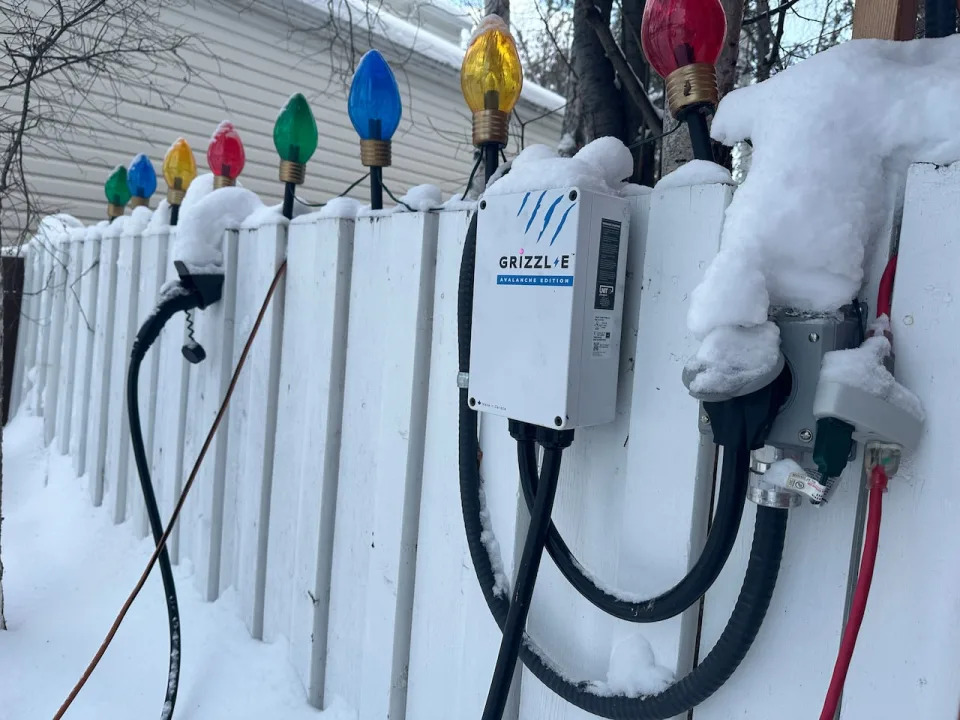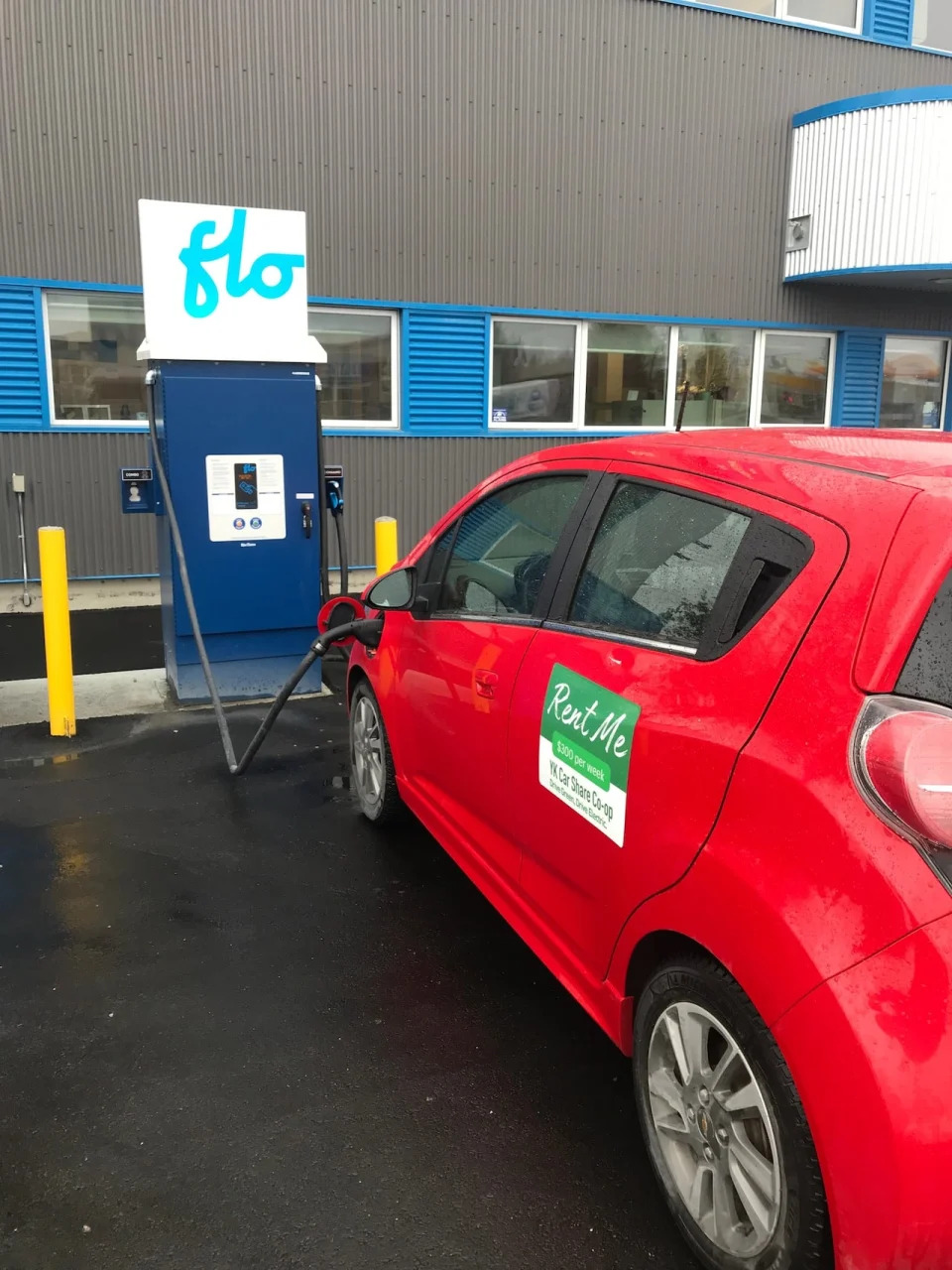CBC
Sat, December 30, 2023

Prime Minister Justin Trudeau, right, and Ontario Premier Doug Ford, second from right, are shown during an announcement on a Volkswagen electric vehicle (EV) battery plant at the Elgin County Railway Museum in St. Thomas, Ont., on April 21.
(Tara Walton/The Canadian Press - image credit)
Along with the massive recent manufacturing investments in electric vehicle (EV) technology and talks of a greener, decarbonized future, there are some not-so-green problems.
In its latest New Energy Finance report, Bloomberg News predicts there will be some 730 million EVs on the road by 2040. The year before, Bloomberg predicted half of all U.S. vehicle sales would be battery electric by 2030.
In Canada, too, there's talk of a big economic boost with the transition to EVs — including 250,000 jobs and $48 billion a year added to the nation's economy through the creation of a domestic supply chain.
Governments have already invested tens of billions into two EV battery manufacturing plants in southwestern Ontario. However, they come with the environmental dilemma of what to do with the millions of EV batteries when they reach the end of their life.
Dead battery dilemma
"The rules are non-existent," said Mark Winfield, a professor at York University in Toronto and co-chair of the school's Sustainable Energy Initiative. "There is nothing as we talk to agencies on both sides of the border, the federal, provincial, state levels.
Along with the massive recent manufacturing investments in electric vehicle (EV) technology and talks of a greener, decarbonized future, there are some not-so-green problems.
In its latest New Energy Finance report, Bloomberg News predicts there will be some 730 million EVs on the road by 2040. The year before, Bloomberg predicted half of all U.S. vehicle sales would be battery electric by 2030.
In Canada, too, there's talk of a big economic boost with the transition to EVs — including 250,000 jobs and $48 billion a year added to the nation's economy through the creation of a domestic supply chain.
Governments have already invested tens of billions into two EV battery manufacturing plants in southwestern Ontario. However, they come with the environmental dilemma of what to do with the millions of EV batteries when they reach the end of their life.
Dead battery dilemma
"The rules are non-existent," said Mark Winfield, a professor at York University in Toronto and co-chair of the school's Sustainable Energy Initiative. "There is nothing as we talk to agencies on both sides of the border, the federal, provincial, state levels.

The NextStar EV battery plant in Windsor, Ont., is shown under construction in the summer of 2023.
( Patrick Morrell/CBC)
"In the case of Ontario, the answer was actually that we we have no intention of doing anything about this."
When asked for its response, the Ontario Ministry of the Environment, Conservation and Parks did not return a request for comment from CBC News.
Winfield said the fact there is no public policy on the disposal of EV batteries is concerning because a number of the chemicals and components used to make EV batteries, such as cadmium, arsenic and nickel are listed as toxic under the Canadian Environmental Protection Act (CEPA) and simply can't be thrown into a landfill.
"You would think given the nature of of these products and also the scale of the potential looming problem, as you know, when the EV sales move into the tens of millions and every one of those ultimately is going to result in an end-of-life battery. One would have expected regulators to be a little bit of further ahead of the curve."
Critical minerals come with costs
The environmental costs of a greener future in transportation don't stop at dead batteries. If the country carries through on its plan to build a home-grown supply chain for the critical minerals needed to make EV batteries, it could mean the development of a vast tract of unspoiled nature in Ontario's north.

On a foggy morning, Neskantaga First Nation community members take their cedar canoes to check the fishing nets for sturgeon. The Hudson Bay Lowlands are a globally significant wetland that is home to a number of remote First Nations communities and species at risk, such as the lake sturgeon, seen being hauled into a canoe in this 2022 photo.
(Logan Turner/CBC)
To get the critical minerals necessary to build EV batteries, Canada will have to develop the Ring of Fire, a deposit of minerals discovered in Ontario's far north in 2007 — one that happens to be in the middle of an environmentally significant area called the Hudson's Bay Lowlands.
"We're talking about a huge wetland," said Dayna Scott, a professor with the Osgoode Law School at York University and the school's research chair in environmental law and justice in the green economy.
"The largest intact boreal forest remaining in the world and also a massive carbon storehouse."
A lot of people who are interested in buying an electric vehicle don't want to see themselves as caught up in an ongoing process of Indigenous dispossession. - Dayna Scott
In the Hudson's Bay Lowlands, there are an estimated 35 billion tonnes of carbon, acts as a major stopover for billions of migratory birds and is home to wolverines, caribou and lake sturgeon — all considered endangered, or species at risk by the federal government.
For years, Scott has studied the social, environmental and legal implications of bringing development to the Hudson's Bay Lowlands and its effect on the rights and interests of remote Indigenous communities there.
"They hold the inherent jurisdiction to be the decision-makers for those lands. They also hold a right of free, prior and informed consent, which comes from international law. That means [governments] need to get the consent of all of the communities that are going to be impacted by this major irreversible change to their way of life."
The Indigenous communities fall under the James Bay Treaty, or Treaty 9 and while some favour development, others are opposed.
To curry their favour, those for and against development are both using climate and the environment to justify their cause, Scott said.
She said those who want to mine critical minerals in the area argue that would lead to a reduction in emissions and save the planet, while those who want to leave the area untouched argue destroying one of the world's largest carbon sinks by developing it would only undo all those emission reductions from EV batteries.
While it's impossible to tell who's right, Scott said governments need buy-in from every First Nation in the Treaty 9 area or any development would be open to litigation — some rarely mentioned at news conferences or funding announcements about the upcoming switch to Canadian-made EV batteries.
"A lot of people who are interested in buying an electric vehicle don't want to see themselves as caught up in an ongoing process of Indigenous dispossession," Scott said. "If people did have to confront at what cost we are going to get these minerals, do we want to do it over Indigenous People's objections?
"I think that would give a lot of people in southern Ontario pause, probably."
To get the critical minerals necessary to build EV batteries, Canada will have to develop the Ring of Fire, a deposit of minerals discovered in Ontario's far north in 2007 — one that happens to be in the middle of an environmentally significant area called the Hudson's Bay Lowlands.
"We're talking about a huge wetland," said Dayna Scott, a professor with the Osgoode Law School at York University and the school's research chair in environmental law and justice in the green economy.
"The largest intact boreal forest remaining in the world and also a massive carbon storehouse."
A lot of people who are interested in buying an electric vehicle don't want to see themselves as caught up in an ongoing process of Indigenous dispossession. - Dayna Scott
In the Hudson's Bay Lowlands, there are an estimated 35 billion tonnes of carbon, acts as a major stopover for billions of migratory birds and is home to wolverines, caribou and lake sturgeon — all considered endangered, or species at risk by the federal government.
For years, Scott has studied the social, environmental and legal implications of bringing development to the Hudson's Bay Lowlands and its effect on the rights and interests of remote Indigenous communities there.
"They hold the inherent jurisdiction to be the decision-makers for those lands. They also hold a right of free, prior and informed consent, which comes from international law. That means [governments] need to get the consent of all of the communities that are going to be impacted by this major irreversible change to their way of life."
The Indigenous communities fall under the James Bay Treaty, or Treaty 9 and while some favour development, others are opposed.
To curry their favour, those for and against development are both using climate and the environment to justify their cause, Scott said.
She said those who want to mine critical minerals in the area argue that would lead to a reduction in emissions and save the planet, while those who want to leave the area untouched argue destroying one of the world's largest carbon sinks by developing it would only undo all those emission reductions from EV batteries.
While it's impossible to tell who's right, Scott said governments need buy-in from every First Nation in the Treaty 9 area or any development would be open to litigation — some rarely mentioned at news conferences or funding announcements about the upcoming switch to Canadian-made EV batteries.
"A lot of people who are interested in buying an electric vehicle don't want to see themselves as caught up in an ongoing process of Indigenous dispossession," Scott said. "If people did have to confront at what cost we are going to get these minerals, do we want to do it over Indigenous People's objections?
"I think that would give a lot of people in southern Ontario pause, probably."
Study forecasts challenges of electric vehicle chargers on northern power grids
CBC
Fri, December 29, 2023

A Level 2 electric vehicle charger at a home in Yellowknife on Dec. 27, 2023.

The Yellowknife Car Share Co-op's Chevrolet Bolt plugged in at a Level 3 charger at the Northland Utilities office in Yellowknife in October 2023.
CBC
Fri, December 29, 2023

A Level 2 electric vehicle charger at a home in Yellowknife on Dec. 27, 2023.
(Liny Lamberink/CBC - image credit)
A study is revealing some of the challenges that electric vehicles will pose to northern power grids — and it'll likely be revised now that Canada has a plan for phasing out the sale of gas-powered cars and trucks.
"At no point in our studies did we consider 100 per cent electric vehicle adoption," said Michael Ross, a researcher at Yukon University who is leading the study.
Ross, an industrial chair in northern energy innovation, said his research is looking at slow to high adoption rates of electric vehicles in Dawson City and parts of Whitehorse and Yellowknife. So far, it's showing some of the ways residential power grids will be strained if people in those neighbourhoods add Level 2 electric vehicle charging stations to their homes, he said.
But on the heels of Canada's announcement, he'll likely add case studies for very high adoption now. There's still time. Ross doesn't expect the study's findings to be published until November 2024.
Regulations announced by the federal government earlier this month give automakers the next 12 years to phase out the manufacturing of combustion engine cars, trucks and SUVs. There's also a requirement to gradually increase the proportion of electric models they offer for sale each year.
Ross said the study, funded by power utilities in all three territories, won't just outline all the challenges that may arise as interest in electric vehicles — and the means to charge them — grows. It'll also contain solutions or ways to mitigate those issues.
Faster charging needs more power
Jay Massie, the vice president of northern development and Indigenous relations for ATCO Electric, said ATCO already has a "good understanding" of what electrification will do to northern power grids.
"The fast chargers … are significant electrical loads on the grid, so it's just an increased demand and strain," he explained. "The faster they charge, the more electricity they need."
A common electrical outlet in a home supplies about 120 volts of electricity. It's compatible with a Level 1 charger, which can take up to 50 hours to fully charge an electric vehicle, and which may be suitable for the smaller batteries of plug-in hybrid vehicles.
A study is revealing some of the challenges that electric vehicles will pose to northern power grids — and it'll likely be revised now that Canada has a plan for phasing out the sale of gas-powered cars and trucks.
"At no point in our studies did we consider 100 per cent electric vehicle adoption," said Michael Ross, a researcher at Yukon University who is leading the study.
Ross, an industrial chair in northern energy innovation, said his research is looking at slow to high adoption rates of electric vehicles in Dawson City and parts of Whitehorse and Yellowknife. So far, it's showing some of the ways residential power grids will be strained if people in those neighbourhoods add Level 2 electric vehicle charging stations to their homes, he said.
But on the heels of Canada's announcement, he'll likely add case studies for very high adoption now. There's still time. Ross doesn't expect the study's findings to be published until November 2024.
Regulations announced by the federal government earlier this month give automakers the next 12 years to phase out the manufacturing of combustion engine cars, trucks and SUVs. There's also a requirement to gradually increase the proportion of electric models they offer for sale each year.
Ross said the study, funded by power utilities in all three territories, won't just outline all the challenges that may arise as interest in electric vehicles — and the means to charge them — grows. It'll also contain solutions or ways to mitigate those issues.
Faster charging needs more power
Jay Massie, the vice president of northern development and Indigenous relations for ATCO Electric, said ATCO already has a "good understanding" of what electrification will do to northern power grids.
"The fast chargers … are significant electrical loads on the grid, so it's just an increased demand and strain," he explained. "The faster they charge, the more electricity they need."
A common electrical outlet in a home supplies about 120 volts of electricity. It's compatible with a Level 1 charger, which can take up to 50 hours to fully charge an electric vehicle, and which may be suitable for the smaller batteries of plug-in hybrid vehicles.

The Yellowknife Car Share Co-op's Chevrolet Bolt plugged in at a Level 3 charger at the Northland Utilities office in Yellowknife in October 2023.
(Yellowknife Car Share Co-operative Ltd./Facebook)
The study is looking at Level 2 chargers, which require a 208-volt or 240-volt wall outlet — the same as dryers, ovens and air conditioners. A Level 3, the fastest type of charger available, needs a 480-volt outlet. They're typically found in public places and businesses.
The challenge with electrification will be balancing the demand for power while keeping the supply on the rest of the system stable and reliable.
Transformers, the big green boxes you see in a neighbourhood, increase or decrease the voltage of electricity flowing through an energy grid. Ross said some transformers are "underrated," meaning they weren't designed to have a lot of electric vehicles integrated into them.
Chargers can also be a "very big power draw," he said, and some homes may experience an undervoltage while their vehicle is charging. That means the power on the system drops below the "acceptable voltage," which could damage equipment.
"We want to say with a certain rate of adoption, we anticipate this particular transformer to have capacity issues and here are some specific ways that could be addressed," Ross explained. "We want to be very specific and deliberate, but not prescriptive, on what needs to be done."
'There's going to be cost'
In order to keep up with whatever demand there may be in the future, Massie said utility companies will be looking at upgrading or building new infrastructure.
"There's going to be cost to the system," he said. Understanding what those costs will be, he said, will help utilities and governments figure out a way forward.
"For utilities, the only spot for us to recoup costs is from ratepayers," he said. He said utilities, like ATCO, will need to work with government to make sure that costs of upgrading the system and meeting peoples' power needs are not "unreasonably borne" on people who aren't buying electric vehicles.
Canada's plan to phase out the manufacturing of gas-powered vehicles, Massie said, came as a bit of surprise.
"We understand the need for electrification and for reducing greenhouse gas emissions for sure. We just want to ensure it's done in a measured and coordinated manner and I think this study is a really good step in that direction."
The study is looking at Level 2 chargers, which require a 208-volt or 240-volt wall outlet — the same as dryers, ovens and air conditioners. A Level 3, the fastest type of charger available, needs a 480-volt outlet. They're typically found in public places and businesses.
The challenge with electrification will be balancing the demand for power while keeping the supply on the rest of the system stable and reliable.
Transformers, the big green boxes you see in a neighbourhood, increase or decrease the voltage of electricity flowing through an energy grid. Ross said some transformers are "underrated," meaning they weren't designed to have a lot of electric vehicles integrated into them.
Chargers can also be a "very big power draw," he said, and some homes may experience an undervoltage while their vehicle is charging. That means the power on the system drops below the "acceptable voltage," which could damage equipment.
"We want to say with a certain rate of adoption, we anticipate this particular transformer to have capacity issues and here are some specific ways that could be addressed," Ross explained. "We want to be very specific and deliberate, but not prescriptive, on what needs to be done."
'There's going to be cost'
In order to keep up with whatever demand there may be in the future, Massie said utility companies will be looking at upgrading or building new infrastructure.
"There's going to be cost to the system," he said. Understanding what those costs will be, he said, will help utilities and governments figure out a way forward.
"For utilities, the only spot for us to recoup costs is from ratepayers," he said. He said utilities, like ATCO, will need to work with government to make sure that costs of upgrading the system and meeting peoples' power needs are not "unreasonably borne" on people who aren't buying electric vehicles.
Canada's plan to phase out the manufacturing of gas-powered vehicles, Massie said, came as a bit of surprise.
"We understand the need for electrification and for reducing greenhouse gas emissions for sure. We just want to ensure it's done in a measured and coordinated manner and I think this study is a really good step in that direction."
No comments:
Post a Comment